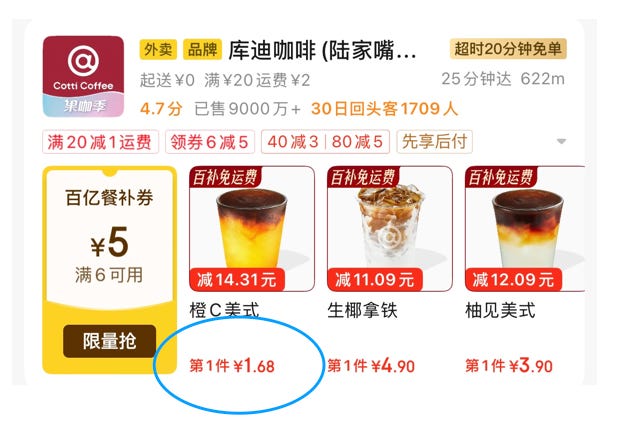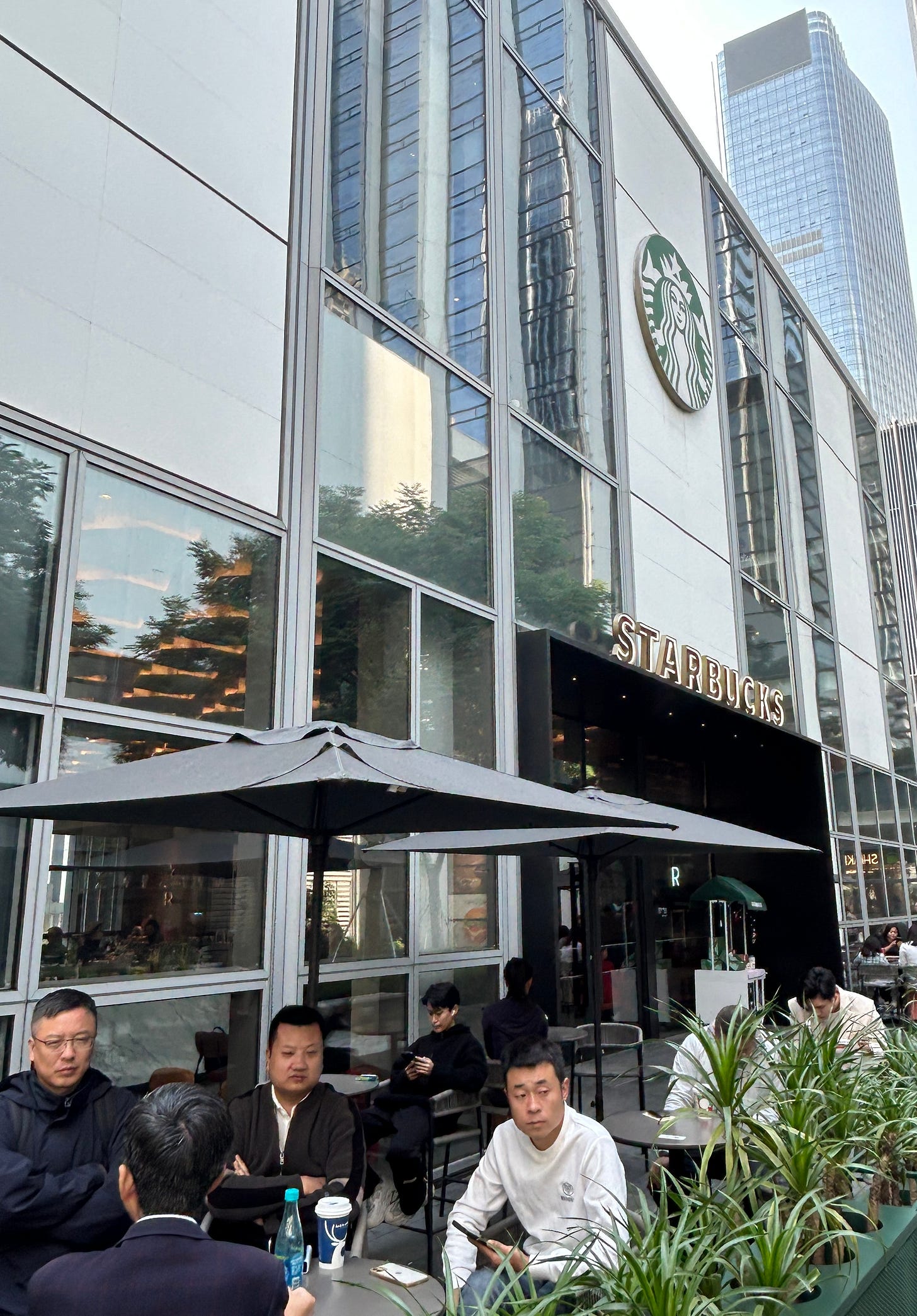Why Starbucks Isn’t Even Trying to Fight the Coffee War in China
While Luckin Coffee and Cotti Coffee slash prices and launch new drinks overnight, Starbucks watches from the sidelines.
Notes from the Frontlines of China’s Coffee Price Meltdown
There’s a full-blown coffee war raging in China. I recently ordered a coffee from Cotti on JD delivered to my door for 1.68 RMB. Yes, you read that right: 1.68. That’s well below raw material cost, unless they’ve figured out how to roast sawdust.
Not too long ago, coffee in Shanghai hovered around ¥20 per cup. Then came the battle between Luckin, Cotti, and others, dragging prices down to ¥9.9 (about $1.37),a price point that has somehow become the new normal. Now consumers expect it. And while ¥9.9 sounds absurdly cheap if you’re used to paying 5, 6, or 7 dollars for a burnt bean latte in the West, I never understood that pricing to begin with. If you’ve ever looked at raw material costs, it’s a scam wrapped in a foam top.
At ¥9.9, you’re at least covering your coffee bean and milk bill and probably eking out a small margin. It’s not glamorous, but with huge volume it’s working and it’s keeping competitors with weaker supply chains at bay. It’s normalizing coffee consumption in a country that never had a habit of drinking the stuff in the first place.
But just as the dust was starting to settle, in marched the tea chains.
Chains like Gu Ming (Good Me), Chagee, Mixue, and Auntea Jenny now find themselves with IPO money burning holes in their pockets—and managements that feel compelled to spend it. Not all of them are entering the coffee ring, but some certainly are. And even those that aren’t are expanding aggressively, pushing well beyond traditional tea. Calling them “tea chains” is increasingly misleading, I describe them as liquid desserts shops. Add to this the all-out instant retail war between JD, Meituan, and Alibaba’s Ele.me, and what you get is one thing: total price destruction.
These rock-bottom prices are, of course, unsustainable. Even running a ¥9.9 operation requires serious logistics and ruthless supply chain execution. But now we’re seeing ¥3.9s and sub ¥2s floating around. Luckin says it’s just for the Dragon Boat Festival. Sure. And my ¥1.68 coffee came with a unicorn horn.
Hmm. Noticed how Starbucks has been awfully quiet in this price war? The other day, I had a discussion with someone who said, “See? Your criticism of Starbucks isn’t fair. They’re strong. They don’t need to compete in this race to the bottom. Their brand stands apart - they can still charge ¥30+ per cup.”
Sounds reasonable—until you actually think about it. Starbucks isn’t staying out because they’re strong. They’re staying out because they can’t compete.
How to Lose a Market: Starbucks China Edition
Let me be clear: I’m talking about Starbucks in China. I have no opinion on what they do elsewhere. But in China, they’ve walked themselves into a strategic cul-de-sac, and I see no realistic way out.
A decade ago, they got off to a great start. Back when coffee was rather rare and exotic in China, Starbucks rolled in and set the gold standard. The brand was strong. Competition was weak. My wife, who worked in real estate at the time, used Starbucks as a quick but reliable gauge for which parts of the city were on the rise. If a new Starbucks opened in a neighborhood, you knew it was an up-and-coming area and that property values were likely rising in parallel.
But then came competition—and Starbucks didn’t budge. Luckin overhauled the whole store format: app-only ordering, minimal seating, delivery-focused design, super short prep times. And I can hardly overstate how important that last point is. When you watch how quickly Luckin or Chagee, for that matter can churn out drinks compared to more traditional players, it’s clear this isn’t accidental. The products are carefully engineered for speed. It’s a massive operational advantage one you won’t find broken out in any earnings report, but one that plays out visibly, cup by cup, on the ground.
And Luckin harvested all the consumer data along the way. They know exactly which products are gaining traction, who the repeat customers are, how often they come back, and what keeps them hooked. Meanwhile, Starbucks is still out there serving venti lattes in cathedral-sized shops, flying blind—no real data insights, just blind faith that the brand alone will keep people walking through the door.
Those huge seating areas in China are economic sinkholes. You walk into any Starbucks and count. At least 30% of people aren’t even drinking a Starbucks product. They’re just there—doing meetings, charging phones, loitering with Wi-Fi. Some aunties unwrapping their self-brought baozi like it’s their personal canteen. I’ve done it too. My wife used to meet clients at Starbucks, offer to buy them coffee (they refused—they didn’t like coffee), sign the paperwork, drink the complimentary water, and leave. Cost of business: zero.
This is one of my favorite pictures of all time I took in Shenzhen. I call it: Starbucks China short thesis in one picture1.
So Starbucks tried to pivot. They rolled out something called “Starbucks Now,” mimicking the Luckin format—no seating, fast service. The problem? You can’t sell the same coffee at half the price just because the chair is missing. Customers don’t buy that logic. So Starbucks remains stuck with its premium pricing model, largely to subsidize all that real estate and square footage.
And that’s why they can’t join the price war. Their model—with oversized stores and heavy overhead—locks them into a much higher cost structure. They simply can’t offer a ¥9.9 latte without burning cash. Meanwhile, the leaner players with tight supply chains and no seating still make money at that price. Starbucks isn’t staying out they’re priced out.
When Price Is Out of Reach—Can Quality Save Them?
So Starbucks can’t compete on price. Can they at least compete on taste and quality? Can they win over the high quality customers?
If you’ve enjoyed the caffeine-soaked sarcasm so far, consider upgrading your subscription. Behind the paywall, I break down Starbucks’ competitive position in China—how their product lineup holds up, how the brand is perceived, and whether this is a comeback story or a slow-drip exit.
Keep reading with a 7-day free trial
Subscribe to The Great Wall Street to keep reading this post and get 7 days of free access to the full post archives.





